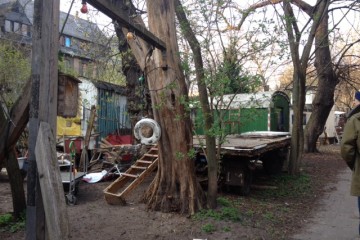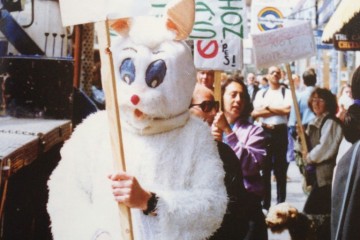The City That Was: 1907 Golden Gate
In The City That Was, Bohemian Archivist P Segal tells a weekly story of what you all missed: the days when artists, writers, musicians, and unemployed visionaries were playing hard in the city’s streets and paying the rent working part time.
Long before this city got its new face, it was a broke-ass paradise. In those days, rents were cheap and the city was full of artists, writers, pranksters, and unemployed visionaries. There were also a lot of abandoned buildings in the city, which were very good for playing in, if you didn’t mind a little B&E.
One of the places in the city where playing was elevated to an art form was my old flat, 1907 Golden Gate. By the time I moved out, 10 years ago, I’d lived there for more than a third of my life. It’s where I met Broke-Ass Stuart, one of the last new roomies before we got evicted for the crime of below market rent, disguised as an owner move-in. It’s where Broke-Ass Stuart was conceived, out of the superb raw material of Stuart himself.
This flat will keep coming up in stories, so I’ll start at the beginning. When I found it, I had a small flat all to myself in North Beach, working part time. I got my first owner move-in eviction from the North Beach flat, which had been previously lived in by three famous poets.
There were no vacancies anywhere in North Beach at the time. Some things never change. I started looking, reluctantly, in other neighborhoods, and found an ad for 1907, 4800 square feet and two stories, room for lots of arty types, at $1800 a month.
It was in the Western Addition area now called NOPA, then a hard-core inner city ghetto. All the houses were fairly derelict and had iron grills at street level. Most of Divis was boarded up. There were no cafes. The building manager who showed me 1907, Bryan, was a speed freak. But the place had columns and fireplaces and an all redwood back parlor.
I moved in with four friends on Halloween, 1984. Our neighbor was a storefront preacher who lived with two hookers, and there was a whorehouse around the corner with a classic red light. The sweet old lady down the block ran a thriving Little Las Vegas in her in-law unit., and our intersection featured a very lively crack trade. But the neighbors were friendly. One of the local dealers always insisted on carrying my groceries home and calling me “Lady P.”
Bryan told us that the Brown Brothers, designers of City Hall, built the place for themselves in 1902. It was condemned by the early ‘70s and bought by a Canadian guy who fixed it up. We found lots of electrical outlets and ceiling hooks upstairs and figured he’d done some indoor agriculture to pay the mortgage. When he bought the building, the tenant in 1907 was a woman with 19 children. All her offspring plied some kind of criminal trade, and Mom collected welfare checks under 27 different names.
In the first heady days of living at 1907, everything was pretty exciting, except for one thing. We began suspecting that Bryan was sneaking into the flat and spying on us from the hallway outside the kitchen. It was a long, twisting corridor, very badly lit. Midway through the house, it opened onto a small square space we called “The Room of Doors.” Seven doorways covered the walls all around; one led to the next hallway, the vestibule, and the 44 steps to the street. It was easy to slip out unseen.
One night, we were sure Bryan was lurking, and one roommate had an unloaded shotgun ready. We talked loudly to cover his movement as he slipped into the hallway and held the shotgun up in our manager’s face.
“You’re not going to shoot me, are you?” Bryan croaked.
“If we see you in our apartment again, you’ll be treated like any other intruder,” my roommate advised calmly. So Bryan stayed downstairs after that, and we alerted the landlord that he had a nut case on the premises. A week later, Bryan was carted off by the police— for something other than lurking in our hallway. We probably didn’t want to know why.
NOPA, 1984: it was still the very wild west.
The wonderful drawing of 1907 is by former inmate Kevin Evans, from Tales of the San Francisco Cacophony Society, edited by John Law, Carrie Galbraith, and Kevin Evans.
Like this article? Make sure to sign up for the BAS mailing list so you never miss a goddamn thing!










